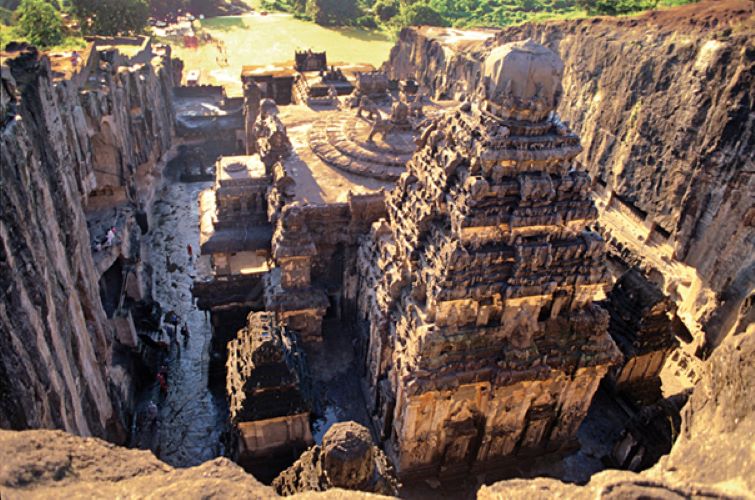Ellora: A Vision of Grandeur

Kailashanatha Temple, Cave 16, Ellora, Maharashtra
Benoy K Behl
The rock-cut caves of ancient India, carved out of the hard rock of mountains, are among the greatest body of the monuments of mankind. It is amazing to see the scale and grandeur of these, as well as the sophisticated and detailed sculpture within them.
From the time of Emperor Ashoka in the 3rd century BCE, great caves were carved out of the rock in India. While houses and other secular buildings were made of wood and other ephemeral materials, that which was made in service of the eternal, was made deep in the heart of the mountain.
The site of Ellora, on the outskirts of the city of Aurangabad in Maharashtra, witnessed the grand culmination of more than a thousand years of the rock cutting tradition. From the 6th century CE till the 10th, the last caves to be made for the Buddhist, Hindu and Jaina faiths were created here, in overlapping periods. Thirty-five caves were cut out of the western face of an outcrop of the Sahyadari Hills.
The Buddhist caves at Ellora were made in the 7th century. These are the largest Buddhist excavations to be carried out in India.
The grand climax of rock-cut architecture in India is in Cave 16, the Kailashanatha temple. This is the largest and most magnificent excavation of the world.
The entire hillside has been transformed into a great temple, with structures carved both inside and out. The scale is breathtaking. From the courtyard the temple rises over a hundred feet.
It involved the removal of some 200 thousand tonnes of rock and it would have taken some 100 years to complete. It is estimated that some 2 million cubic feet of rock were cleared to make way for the Kailashanatha temple.
The courtyard goes 276 feet into the heart of the rock and is 154 feet wide. At the back, the vertical drop from the hillside is 120 feet. The planning of the excavation had to be extremely sophisticated, as it depended upon what was cut and removed, rather than what was added, as in conventional architecture.
The 9th century at Ellora saw the making of Jaina caves. Cave 30 is called Chota Kailasha, as it is a much smaller version of the grand Kailashanatha temple. Surviving murals on the ceiling of the caves are very valuable as they mark the beginnings of the stylised medieval idiom in Indian paintings.
These caves mark the end of the great tradition of rock-cut temples in India. For 1200 years, sanctuaries were hewn out of the rock. These took us far from the clamour and anxieties of the material world outside. Deep in the heart of the mountain, the devotee could meditate upon symbols and personifications of the finest qualities, within each of us.
Under its series Glimpses Of Culture, India Habitat Centre is presenting a talk by Art Historian,
Film-maker & Photographer (and the author of this article) Benoy K Behl tomorrow (July 27) at 6pm.
A film ‘Ellora: A Vision of Grandeur’ (produced by Behl for Doordarshan)
will also be screened on the occasion.
Click here to join

